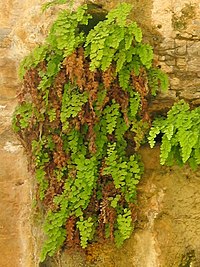Adiantum capillus-veneris
| Adiantum capillus-veneris | |
|---|---|

| |
| Scientific classification | |
| Kingdom: | Plantae |
| Clade: | Tracheophytes |
| Division: | Polypodiophyta |
| Class: | Polypodiopsida |
| Order: | Polypodiales |
| Family: | Pteridaceae |
| Genus: | Adiantum |
| Species: | A. capillus-veneris
|
| Binomial name | |
| Adiantum capillus-veneris | |
Adiantum capillus-veneris,theSouthern maidenhair fern,black maidenhair fern,maidenhair fern,[3]andvenus hair fern,is a species offernsin the genusAdiantumand the familyPteridaceae[4]with a subcosmopolitan worldwide distribution. It is cultivated as a populargarden fernandhouseplant.[5]
Distribution[edit]
Adiantum capillus-venerisis native to the southern half of the United States fromCaliforniato the Atlantic coast, through Mexico and Central America, to South America. It is also native toEurasia,theLevantinWestern Asia,andAustralasia.[5][6][7]There are two disjunct occurrences in the northern part of North America: at Cascade Springs in theBlack HillsofSouth DakotaandFairmont Hot Springs, British Columbia.In both instances, the warm microclimate created by hot mineral springs permits the growth of the plant far north of its normal range. It is similar in Zvonce spa resort (Звоначка Бања, Zvonačka Banja), near Pirot in Serbia, where hot mineral springs provide adequate heat and humidity for the survival of this species.[8]
It is found in temperate climates from warm-temperate to tropical, where the moisture content is high but not saturating, in the moist, well-drained sand, loam or limestone of manyhabitats,including rainforests, shrub and woodlands, broadleaf and coniferous forests, and desert cliffseeps,andsprings.It often may be seen growing on moist, sheltered and shadedsandstoneorlimestoneformations, generally south-facing in the southern hemisphere, north-facing in the north, or in gorges.[5]It occurs throughout Africa in moist places by streams.[9]On moist sandstone cliffs it grows in full or partial shade, even when unprotected.[10]


Description[edit]
Adiantum capillus-venerisgrows from 6 to 12 in (15 to 30 cm) in height; its fronds arising in clusters from creeping rhizomes 8 to 27.5 in (20 to 70 cm) tall, with very delicate, light greenfrondsmuch subdivided into pinnae 0.2 to 0.4 in (5 to 10 mm) long and broad; the frond rachis is black and wiry.[5][7]
Cultivation[edit]
Adiantum capillus-venerisis cultivated and widely available around the world for planting innatural landscapenative plantsand traditionalshade gardens,for outdoorcontainer gardens,and commonly as an indoorhouseplant.
Adiantum × mairisiiis a winter hardy hybrid ofAdiantum capillus-veneriswith another species, which is likely to be one ofAdiantum raddianum,Adiantum aethiopicum,orAdiantum cuneatum.[11]
As a houseplant,Adiantum capillus-venerisrequires filtered light and very humid conditions. It should be grown in soil rich in organic matter and should be watered frequently but lightly, to keep the roots damp but not drenched. The temperature should not fall below 12 °C (54 °F). It is propagated by dividing, making sure each clump has a section of rhizome.[12]
Conservation[edit]
The fern is listed as anendangered speciesinNorth Carolina(as southern maidenhair-fern) andthreatened speciesinKentucky(as venus hair fern), due to loss ofAppalachianhabitat.
Traditional uses[edit]
This plant is used medicinally by Native Americans. TheMahuna peopleuse the plant internally for rheumatism,[13]and theNavajo peopleofKayenta, AZuse aninfusionof the plant as a lotion for bumblebee and centipede stings.[14]The Navajo people also smoke it or take it internally to treat mental illness.[14]
In the traditional medicine of Iran, frond infusion ofAdiantum capillus-venerisis used forjaundicetherapy.[15]Along with this, they have a wide range of medicinal uses and have been used to treat coughs, cold, and to aid in kidney function.[16]
References[edit]
- ^Lansdown, R.V. & Bilz, M. (2018)."Adiantum capillus-veneris".IUCN Red List of Threatened Species.2018:e.T164082A67770327.doi:10.2305/IUCN.UK.2018-2.RLTS.T164082A67770327.en.Retrieved21 September2022.
- ^"NatureServe Explorer 2.0 -Adiantum capillus-venerisSouthern Maidenhair Fern ".explorer.natureserve.org.Retrieved9 October2020.
- ^BSBI List 2007(xls).Botanical Society of Britain and Ireland.Archived fromthe original(xls)on 2015-06-26.Retrieved2014-10-17.
- ^Christenhusz, Maarten J. M.;Zhang, Xian-Chun; Schneider, Harald (2011)."A linear sequence of extant families and genera of lycophytes and ferns"(PDF).Phytotaxa.19:7–54.doi:10.11646/phytotaxa.19.1.2.
- ^abcdWildflower.org-NPIN: Adiantum capillus-veneris (Southern maidenhair fern).accessed 4.04.2011
- ^The University of the West Indies, Cave Hill
- ^abCundall. P., (2004) Native Plants:The definitive guide to Australian plants, Global Book Publishing Lane Cove, N.S.W, p.298,ISBN978-1-74048-027-7
- ^"Zaštićeno jedino stanište venerine vlasi u Srbiji"[The Only Habitat of the Venus Hair Fern in Serbia is Now Protected].Pirotske Vesti(in Serbian). 11 December 2015.
- ^Sim, Thomas Robertson (1915).The Ferns of South Africa.London & Edinburgh: Cambridge University Press.
- ^Roux, J.P. (1979).Cape Peninsula Ferns.Kirstenbosch: National Botanic Gardens of South Africa.ISBN978-0-620-03775-4.
- ^"Pacific Horticulture | Pacific Plant Promotions: Adiantum xmairisii".Pacific Horticulture.Retrieved2021-07-21.
- ^Chiusoli, Alessandro; Boriani, Luisa Maria (1986).Simon & Schuster's guide to houseplants.New York: Simon and Schuster.ISBN0671631314.
- ^Romero, John Bruno 1954 The Botanical Lore of the California Indians. New York. Vantage Press, Inc. (p. 60)
- ^abWyman, Leland C. and Stuart K. Harris 1951 The Ethnobotany of the Kayenta Navaho. Albuquerque. The University of New Mexico Press (p. 14)
- ^Tewari, Devesh; Mocan, Andrei; Parvanov, Emil D.; Sah, Archana N.; Nabavi, Seyed M.; Huminiecki, Lukasz; Ma, Zheng Feei; Lee, Yeong Yeh; Horbańczuk, Jarosław O.; Atanasov, Atanas G. (2017)."Ethnopharmacological Approaches for Therapy of Jaundice: Part I".Frontiers in Pharmacology.8:518.doi:10.3389/fphar.2017.00518.PMC5559545.PMID28860989.
- ^Al Snafi, Ali (2015)."The Chemical Constituents and Pharmacological Effects ofAdiantum Capillus-Veneris".Asian Journal of Pharmaceutical Science & Technology.5(2).
External links[edit]
- Adiantum capillus-veneris- Southern maidenhair fern — U.C. Cal-Photo Gallery
- USDA Profile for Adiantum capillus-veneris (common maidenhair fern)
- "Adiantum capillus-veneris".Germplasm Resources Information Network.Agricultural Research Service,United States Department of Agriculture.
- U.C. Jepson Manual treatment forAdiantum capillus-veneris
- Adiantum capillus-venerisin the Canary Islands
- Chrono.uk: Spore-pollen studies
- Lady Bird Johnson Wildflower Center - Horticultural Growing Conditions and Propagation
- IUCN Red List least concern species
- NatureServe secure species
- Adiantum
- Ferns of the Americas
- Ferns of Australasia
- Ferns of Europe
- Ferns of Asia
- Plants described in 1753
- Taxa named by Carl Linnaeus
- Plants used in traditional Native American medicine
- Garden plants of North America
- Garden plants of Asia
- Garden plants of Europe
- House plants


